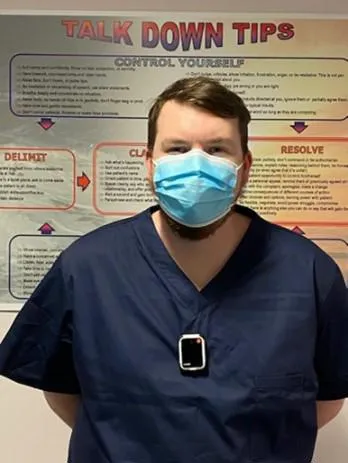Body Worn Cameras on Inpatient Mental Health Wards
As part of the violence reduction strategy reported by the Government in 2018, the use of Body Worn Cameras was reported to deter violence across a range of services, including their use on inpatient mental health wards. Body worn cameras (BWCs) are mobile audio and video capture devices that can be secured to various parts of the body using different types of attachment, allowing the wearer to record what they see and hear.

© Photo provided courtesy of Northamptonshire Healthcare NHS Trust
Although body worn cameras are deployed in a range of settings including a number of healthcare services, the absence of universal standards or guidelines for how they are used in these environments has raised several policy, ethical and practical concerns. Clinicians and patients have reported strong views and have raised valid ethical concerns about the use of cameras and their potential impact on people at their most vulnerable. Within mental health hospitals, these issues include confidentiality and a lack of awareness or consent amongst patients.
Currently, there is limited availability of published evidence on the effectiveness and acceptability of body worn cameras in healthcare settings.
Our research
We have conducted some of the first and largest independent studies exploring the use of BWCs in inpatient mental health settings. These include a qualitative national study in which we interviewed 33 service users and 31 health professionals across five NHS Trusts and via social media to help us understand the views and experiences of people about the use of BWCs in this setting, and to help identify the possible impact such technology might have on patients, clinicians, and the care being delivered.
The results of the study made it clear that both staff and service users were conflicted and uncertain about the use of body-worn cameras. They raised a number of important issues related to trust, power dynamics and the ethics of using this technology, namely:
- Violence and aggression are complex issues. Some staff perceived acts as deliberate whereas others might see it as an expression of distress with multiple causes or triggers.
- Both staff and patients were concerned that wearing cameras would become a substitute for good care and the use of alternative forms of prevention or de-escalation.
- Body-worn cameras will have particular implications for patients who “already feel criminalised” in an environment where staff have much greater power than patients.
- There is a lack of trust between patients and staff, that could potentially be made worse by body-worn cameras, as staff both wear and control the cameras.
These findings have been used to inform the position statement published in May 2023 by the Royal College of Nursing (RCN).
Results from a mixed methods evaluation study found no clear relationship between the use of BWCs and rates or severity of incidents on either ward, with limited impact of using BWCs on levels of incidents. Qualitative findings noted mixed perceptions about the use of BWCs and highlighted the complexity of implementing such technology as a violence reduction method within a busy healthcare setting Furthermore, the qualitative data collected during this pilot period highlighted the potential systemic and contextual factors such as low staffing that may impact on the incident data presented. These findings suggest that BWCs have a limited impact on levels of incidents on wards, something that is likely to be largely influenced by the process of implementation as well as a range of contextual factors. As a result, it is likely that while BWCs may see successes in one hospital site this is not guaranteed for another site as such factors will have a considerable impact on efficacy, acceptability, and feasibility.
Awards
Our qualitative study exploring the use of BWCs was funded by both The Maudsley Charity and the Florence Nightingale Faculty of Nursing, Midwifery & Palliative Care, King's College London, Research Challenge Fund 2019. Our mixed methods evaluation of BWC use was funded by The Burdett Trust of Nursing. Funders were independent of the research and did not impact findings.
Related papers
Simpson, A. (2023). Surveillance, CCTV and body-worn cameras in mental health care. Journal of Mental Health, 32(2), 369–372.
Wilson, K., Eaton, J., Foye, U., Ellis, M., Thomas, E. and Simpson, A. (2022), What evidence supports the use of Body Worn Cameras in mental health inpatient wards? A systematic review and narrative synthesis of the effects of Body Worn Cameras in public sector services. Int J Mental Health Nurs, 31: 260-277. https://doi.org/10.1111/inm.12954.
Wilson, K., Foye, U., Thomas, E., Chadwick, M., Dodhia, S., Allen-Lynn, J., Allen-Lynn, J., Brennan, G., and Simpson, A. (2023). Exploring the use of body-worn cameras in acute mental health wards: a qualitative interview study with mental health patients and staff. Int J of Nursing Studies, 140, .
Foye, U., Regan, C., Wilson, K., Ali, R., Chadwick, M., Thomas, E., … Simpson, A. (2024). Implementation of Body Worn Camera: Practical and Ethical Considerations. Issues in Mental Health Nursing, 45(4), 379–390. https://doi.org/10.1080/01612840.2024.2308605.





